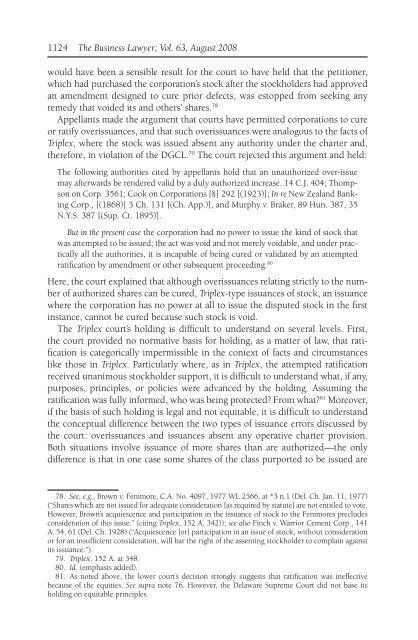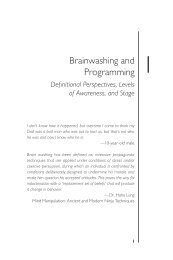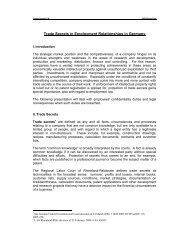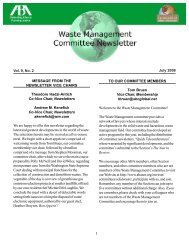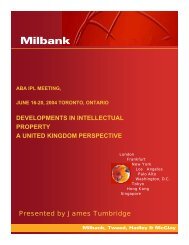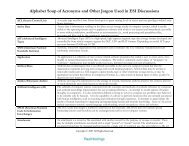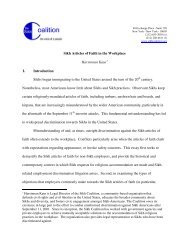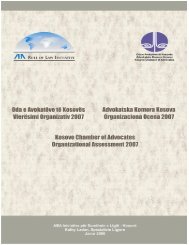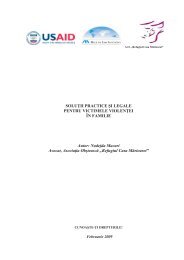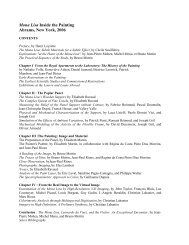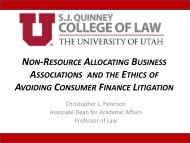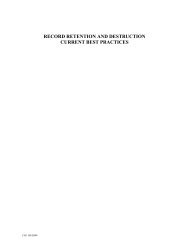Curing Defects in Stock Issuances - American Bar Association
Curing Defects in Stock Issuances - American Bar Association
Curing Defects in Stock Issuances - American Bar Association
Create successful ePaper yourself
Turn your PDF publications into a flip-book with our unique Google optimized e-Paper software.
1124 The Bus<strong>in</strong>ess Lawyer; Vol. 63, August 2008<br />
would have been a sensible result for the court to have held that the petitioner,<br />
which had purchased the corporation’s stock after the stockholders had approved<br />
an amendment designed to cure prior defects, was estopped from seek<strong>in</strong>g any<br />
remedy that voided its and others’ shares. 78<br />
Appellants made the argument that courts have permitted corporations to cure<br />
or ratify overissuances, and that such overissuances were analogous to the facts of<br />
Triplex, where the stock was issued absent any authority under the charter and,<br />
therefore, <strong>in</strong> violation of the DGCL. 79 The court rejected this argument and held:<br />
The follow<strong>in</strong>g authorities cited by appellants hold that an unauthorized over-issue<br />
may afterwards be rendered valid by a duly authorized <strong>in</strong>crease. 14 C.J. 404; Thompson<br />
on Corp. 3561; Cook on Corporations [§] 292 [(1923)]; In re New Zealand Bank<strong>in</strong>g<br />
Corp., [(1868)] 3 Ch. 131 [(Ch. App.)], and Murphy v. Braker, 89 Hun. 387, 35<br />
N.Y.S. 387 [(Sup. Ct. 1895)].<br />
But <strong>in</strong> the present case the corporation had no power to issue the k<strong>in</strong>d of stock that<br />
was attempted to be issued; the act was void and not merely voidable, and under practically<br />
all the authorities, it is <strong>in</strong>capable of be<strong>in</strong>g cured or validated by an attempted<br />
ratifi cation by amendment or other subsequent proceed<strong>in</strong>g. 80<br />
Here, the court expla<strong>in</strong>ed that although overissuances relat<strong>in</strong>g strictly to the number<br />
of authorized shares can be cured, Triplex-type issuances of stock, an issuance<br />
where the corporation has no power at all to issue the disputed stock <strong>in</strong> the fi rst<br />
<strong>in</strong>stance, cannot be cured because such stock is void.<br />
The Triplex court’s hold<strong>in</strong>g is diffi cult to understand on several levels. First,<br />
the court provided no normative basis for hold<strong>in</strong>g, as a matter of law, that ratifi<br />
cation is categorically impermissible <strong>in</strong> the context of facts and circumstances<br />
like those <strong>in</strong> Triplex. Particularly where, as <strong>in</strong> Triplex, the attempted ratifi cation<br />
received unanimous stockholder support, it is diffi cult to understand what, if any,<br />
purposes, pr<strong>in</strong>ciples, or policies were advanced by the hold<strong>in</strong>g. Assum<strong>in</strong>g the<br />
ratifi cation was fully <strong>in</strong>formed, who was be<strong>in</strong>g protected? From what? 81 Moreover,<br />
if the basis of such hold<strong>in</strong>g is legal and not equitable, it is diffi cult to understand<br />
the conceptual difference between the two types of issuance errors discussed by<br />
the court: overissuances and issuances absent any operative charter provision.<br />
Both situations <strong>in</strong>volve issuance of more shares than are authorized—the only<br />
difference is that <strong>in</strong> one case some shares of the class purported to be issued are<br />
78. See, e.g., Brown v. Fenimore, C.A. No. 4097, 1977 WL 2566, at *3 n.1 (Del. Ch. Jan. 11, 1977)<br />
(“Shares which are not issued for adequate consideration [as required by statute] are not entitled to vote.<br />
However, Brown’s acquiescence and participation <strong>in</strong> the issuance of stock to the Fenimores precludes<br />
consideration of this issue.” (cit<strong>in</strong>g Triplex, 152 A. 342)); see also F<strong>in</strong>ch v. Warrior Cement Corp., 141<br />
A. 54, 61 (Del. Ch. 1928) (“Acquiescence [or] participation <strong>in</strong> an issue of stock, without considera tion<br />
or for an <strong>in</strong>suffi cient consideration, will bar the right of the assent<strong>in</strong>g stockholder to compla<strong>in</strong> aga<strong>in</strong>st<br />
its issuance.”).<br />
79. Triplex, 152 A. at 348.<br />
80. Id. (emphasis added).<br />
81. As noted above, the lower court’s decision strongly suggests that ratifi cation was <strong>in</strong>effective<br />
because of the equities. See supra note 76. However, the Delaware Supreme Court did not base its<br />
hold<strong>in</strong>g on equitable pr<strong>in</strong>ciples.


